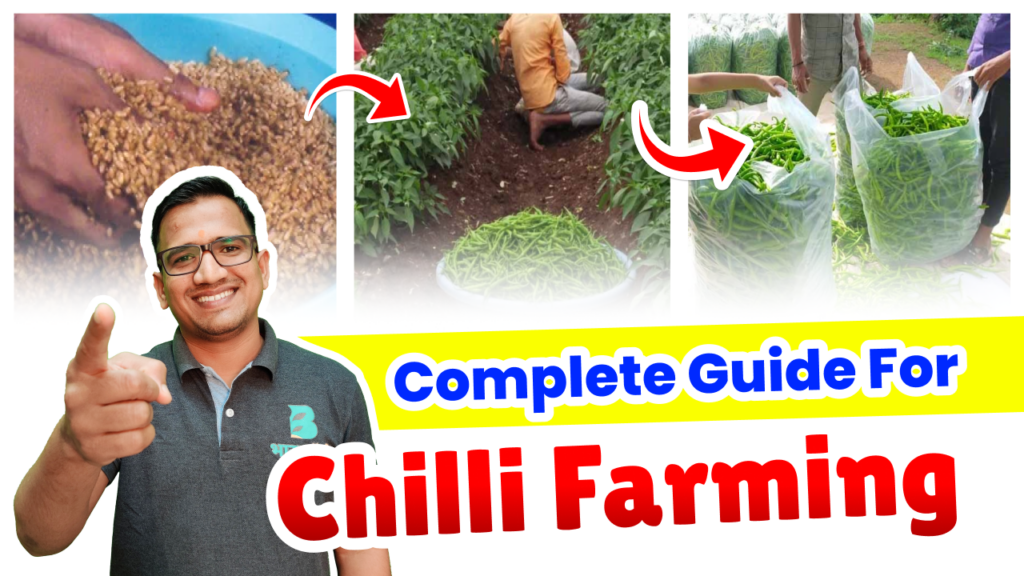
Chilli farming is a vital agricultural activity in India, profoundly contributing to the nation’s economy and diversity. This detailed guide will help farmers with comprehensive knowledge on chilli farming, covering every aspect from land preparation to harvesting and yield management, ensuring a successful and profitable harvest.
Chilli Crop at a Glance
Cropping Season:
Chillies can be cultivated during different seasons:
- Kharif Season: Sown in June-July, harvested in September-October.
- Rabi Season: Sown in October-November, harvested in March-April.
- Summer Season: Sown in January-February, harvested in May-June.
Production and Consumption
India produces approximately 1.3 to 1.5 million tonnes of chillies annually. A significant portion is consumed domestically in fresh and dried forms, while the country also exports substantial quantities.
Export:
India exports chillies to countries including the USA, UK, UAE, Sri Lanka, and Malaysia. Andhra Pradesh’s Guntur district is renowned for high-quality chilli production and is a major exporter.
Types of Chillies in India
India grows a variety of chillies, each with unique properties in terms of pungency, color, and flavor. Some popular types include:
- Guntur Chilli: High pungency, deep red color, mainly grown in Andhra Pradesh.
- Kashmiri Chilli: Mild pungency, rich color, primarily used for its vibrant red hue.
- Byadgi Chilli: From Karnataka, known for its rich red color and mild pungency.
- Jwala Chilli: A popular variety in Gujarat, characterized by moderate heat.
- Sannam S4 Chilli: Widely grown in Andhra Pradesh and Tamil Nadu, known for high pungency and rich color.
Major Chilli Producing States in India
The major chilli producing states in India include:
- Andhra Pradesh (Largest producer, contributing about 50% of total production)
- Karnataka
- Maharashtra
- Madhya Pradesh
- Odisha
- West Bengal
- Gujarat
- Tamil Nadu
Required Climatic Conditions
Chillies thrive in warm, humid climates. The ideal temperature range for chilli cultivation is between 20°C to 25°C. Chillies require ample sunlight and are sensitive to frost. Rainfall of 800-1200 mm per year is sufficient, but excessive moisture or drought can negatively impact growth.
Climate Factors
- Heavy rains and cloudy weather during flowering and fruiting can cause flower and fruit drop.
- High humidity can lead to fruit rotting.
- High light intensity can delay fruit coloring.
- Temperature below 10°C retards plant development.
- Temperature above 30°C at the initial growth stage retards root development.
- Temperature above 37°C adversely affects fruit development.
Soil Requirement
Chillies can be grown in various soils, but well-drained loamy soils rich in organic matter are ideal. The pH range should be between 6.0 and 7.0. Avoid waterlogged and saline soils to prevent root diseases and poor growth.
Soil PH Adjustments
- If pH < 6.5: Add lime.
- If pH > 7.5: Add gypsum.
Land Preparation
Proper land preparation is crucial for healthy chilli growth. Follow these steps:
The land is prepared to achieve a fine tilth through thorough ploughing and use of a Rotavator. For direct sowing, the soil undergoes three to four ploughings, with seeds sown during the final ploughing. Additionally, Trichoderma viride can be applied at 1-2 kg mixed with 50 kg of farm yard manure, broadcast across the field. Farmers may also incorporate 4-6 tonne of farm yard manure and 1-2 tonne of vermicompost per acre to enhance soil fertility and structure.
Sowing
Seed Rate
- For planting chillies, 60-80 grams of seeds are required per acre to ensure optimal crop density and healthy growth.
Variety
Choose high-yielding, disease-resistant varieties suitable for local conditions. Popular varieties of chilli seeds are:
- VNR Sahiba
- Advanta Golden AK 47
- BASF Nunhems Armour
- Mahyco MHCP-319 Navtej
- Syngenta Devsena 88
- Syngenta Almora
- Syngenta HPH 553
- 1 Nunhems Indu
- Sarpan 102 Byadagi
- Umang hybrid F1
Seed Treatment
For effective chilli seed treatment, use Thiamethoxam 30% FS at 10 ml / kg seed to protect against sucking pests. Combine with Carbendazim 50% WP at 3 gm / kg seed to prevent fungal diseases. This dual treatment ensures healthier germination and robust plant growth.
Sowing Method
Nursery Raising
Seeds are sown in well-prepared nursery beds for chilli cultivation, with transplanting preferred for better quality and survival. The nursery bed, elevated from ground level, is prepared with a blend of compost and sand. Treated with Trichoderma, seeds are thinly covered with sand and typically germinate within 5 to 7 days. Seedlings, aged approximately 40 to 45 days, are then transplanted into the main field to facilitate further growth and development.
Transplanting
Transplanting begins with 40-45 day old seedlings, usually placed in shallow trenches, pits, or on ridges and level lands. Spacing varies but commonly includes 120 cm x 60 cm, 90 cm x 30 cm, or 45 cm x 30 cm configurations.
Direct sowing
Direct sowing is commonly used in rainfed agriculture. Seeds are drilled in rows with a seed rate of 1.5-2.0 kg per acre. Thinning and gap filling are typically carried out around 30-40 days after sowing, preferably on cloudy days to optimize plant establishment.
Spacing
Varieties
- Row to Row: 1.9 ft.
- Plant to Plant: 1.9 ft.
- Plant Population: 12,188 plants/acre.
Hybrids
- Row to Row: 4.0 ft.
- Plant to Plant: 2.0 ft.
- Plant Population: 5,500 plants/acre.
Nutrient Management
A balanced nutrient management plan is essential. Apply fertilizers based on soil test results. General recommendations per acre are as follows::
Recommended Dose: 120:80:80 kg / ha
| Stage | Crop stage | Durationin days | Fertilizergrade | Total Fertilizer (kg/ha) | Nutrient supplied | % requirement | ||||
| N | P | K | N | P | K | |||||
| 1 | Transplanting to plant establishment stage | 10 | 19:19:19 13:0:45 Urea | 21.05 8.88 14.86 | 4.00 1.156.83 | 4.00 – – | 4.00 3.98 – | 10.00 | 5.00 | 10.00 |
| Subtotal | 11.9 | 4.00 | 7.98 | |||||||
| 2 | Flower initiation to flowering | 30 | 12:61:0 13:0:45 Urea | 13.11 71.04 80.72 | 1.579.2437.1 | 8.00 – – | – 31.97 – | 30.00 | 10.00 | 20.00 |
| Subtotal | 47.9 | 8.00 | 31.9 | |||||||
| 3 | Flowering set to fruit picking | 30 | 19:19:19 13.0:45 Urea | 21.05 44.40 56.91 | 4.005.7726.1 | 4.00 – – | 4.00 19.98 | 30.00 | 5.00 | 20.00 |
| Subtotal | 35.9 | 4.00 | 23.9 | |||||||
| 4 | Alternate day from picking | 8 | 12:61:0 13:0:45 Urea | 6.52 35.52 40.38 | 0.754.6218.5 | 3.81 – – | – 15.98 | 30.00 | 5.00 | 50.00 |
| Subtotal | 23.9 | 3.81 | 15.9 | |||||||
Irrigation Management
Irrigation is done at weekly intervals, especially during critical stages like flowering and fruit development. Drip irrigation is recommended for efficiency.
Intercultural Operations
Weed Management
- Apply Pendimethalin 30% at 1 liter or Oxyfluorfen 23.5% at 200 ml mixed with 200 liters of water one or two days before planting.
Plastic Mulching
- For Drip Irrigation: Required.
- For Flood Irrigation: Not required.
Crop Protection
Crop protection includes pest and disease management. Below are the pests and diseases that affect chilli crops.
Pest Management
The following pests are harmful to chili farming and directly affect the yield of the chili crop.
Thrips
The infested leaves develop crinkles and curl upwards, Buds become brittle and drop down, Early stage, infestation leads to stunted growth and flower production, fruit set are arrested
Cultural Control : Install Blue sticky traps @ 10 per acre and Uproot the diseased plants and destroy them
Organic control : Spray Azadirachtin or Neem oil @ 2 ml per lit water
Chemical control : Spray any one of the following insecticide
| Insecticide | Dose |
| Imidacloprid 17.8% SL | 0.5 ml/ lit. |
| Dimethoate 30% EC | 2.0 ml/lit. |
| Emamectin benzoate 5% SG | 0.5 gm/lit. |
| Ethion 50 % EC | 2 ml/lit. |
| Fipronil 5 % SC | 1.5 ml/lit. |
| Spinosad 45 % SC | 3.2 ml/10 lit. |
| Thiacloprid 21.7 % SC | 6.0 ml/10 lit. |
Aphids
Aphids cause damage to leaves by sucking the cell sap. Large number of Aphids seen underside of the leaves. Extensive feeding causes plants to turn yellow and the leaves to curl downward and inward from the edges.
Cultural Control : Install yellow sticky traps @ 10 per acre
Organic control : Spray Azadirachtin or Neem oil @ 2 m
l per lit water
Chemical control : Spray any one of the following insecticide
| Insecticide | Dose |
| Carbosulfan 25 % EC | 1.0 ml/lit. |
| Fipronil 5 % SC | 2.0 ml/lit. |
| Imidacloprid 17.8% SL | 0.5 ml/ lit. |
| Quinalphos 25% EC | 2.0 ml/lit. |
Yellow mite
Symptoms of mite infestation on chili crops include downward curling and crinkling of leaves, elongated petioles, and stunted growth.
Organic control : Spray Azadirachtin or Neem oil @ 2 ml per lit water
Chemical control : Spray any one of the following insecticide
| Insecticide | Dose |
|---|---|
| Buprofezin 25 % SC | 8 ml/10 lit. |
| Diafenthiuron 50 % WP | 8 gm/10 lit. |
| Dimethoate 30 % EC | 1 ml/lit. |
| Ethion 50 % EC | 2 ml/lit. |
| Fenazaquin 10 % EC | 2 ml/lit. |
| Propargite 57 % EC | 2.5 ml/lit. |
| Spiromesifen 22.9 % SC | 5 ml/10 lit. |
Fruit Borer
The symptoms of fruit borer infestation on chilli crops include young larvae feeding on tender foliage, mature larvae boring circular holes, and thrusting only part of their bodies into the fruit to eat the inner content.
Organic control : Install pheromone traps @ 5 unit per acre.
| Insecticide | Dose |
| Emamectin benzoate 5% SG | 0.5 gm/ lit. |
| Fipronil 5 % SC | 2 ml /lit. |
| Flubendiamide 20 WDG | 6 gm /10 lit. |
| Flubendiamide 480 SC | 0.4 ml /lit |
Disease Management
The following disease are harmful to chilli farming and directly affect the yield of the chilli crop.
Damping off
Damping off disease in chilli crops manifests as water-soaked lesions at the collar region. The affected areas turn brown and begin to rot. As the tissues soften, the plants eventually shrivel and collapse.
Organic control : Drench the solution of Trichoderma viride 500 gm per acre.
Chemical control : Drench fungicide Carbendazim 50% WP 500 gm or Carbendazim 12% + Mancozeb 63% WP 500 gm
Powdery Mildew
Severe infection results in the drying and shedding of affected leaves Powdery growth can also be seen on branches and young fruits Diseased fruits do not grow further and may drop down prematurely
Organic control : Spray biofungicide Trichoderma viride 200 gm per acre.
Chemical control : Spray fungicide Carbendazim 12% + Mancozeb 63% WP 500 gm or Azoxystrobin 8.3% + Mancozeb 66.7% WG 600 gm or Tebuconazole 50% + Trifloxystrobin 25% WG 100 gm
Bacterial Leaf Spot
Bacterial Leaf Spot disease affects the leaves, fruits, and stems of chili crops. Initially, circular, water-soaked lesions appear on the leaves. These spots then turn necrotic, featuring a brown center surrounded by chlorotic borders.
Organic control : Spray biofungicide Pseudomonas Fluorescens 500 ml per acre.
Chemical control : Spray fungicide Copper Oxychloride 50% WP 500 gm + Plantomycine 100 gm per acre.
Leaf Curl Virus
Chilli leaf curl virus, spread by whiteflies, poses a significant threat to chili crops. The disease symptoms include upward leaf curling, stunted plant growth, and reduced yields.
Cultural Control : Install Blue sticky traps @ 10 per acre and Uproot the diseased plants and destroy them
Organic control : Spray Azadirachtin or Neem oil @ 2 ml per lit water
Chemical control : Spray Geolife No Virus 500 ml with Thiamethoxam 25% WG – 100 gm OR Imidacloprid 17.8% SL 100 ml OR Fipronil 5 % SC 100 ml per acre.
Harvesting & Threshing
Harvesting
Chillies are harvested at different stages based on use:
- Green Chillies: Harvest when fully grown but still green.
- Dry Chillies: Harvest when fruits turn red.
- Dry harvested chillies in the sun for 7-10 days.
- Once dried, thresh to separate seeds from pods.
Yield
Expected Yield
- Standard Farming: 11 tons/acre, income Rs 2,20,000.
- BharatAgri Smart Farming: 15 tons/acre, income Rs 3,00,000.
Conclusion
Chilli farming in India is a promising venture due to high domestic and international demand. By following best practices in land preparation, sowing, irrigation, and pest management, farmers can achieve optimal yields and profitability. This comprehensive guide equips farmers with the knowledge needed for successful chilli cultivation, ensuring a bountiful harvest and improved income.
FAQs
The ideal temperature range for chilli cultivation is between 20°C to 25°C.
For standard farming, 140-180 grams per acre. For BharatAgri smart farming, 60-80 grams per acre.
Common pests include aphids, thrips, and fruit borers.
Chillies require regular irrigation, especially during critical stages like flowering and fruit development. Drip irrigation is recommended for efficiency.
Green chillies should be harvested when fully grown but still green, while dry chillies are harvested when the fruits turn red.
Spray Geolife No Virus 500 ml with Thiamethoxam 25% WG – 100 gm OR Imidacloprid 17.8% SL 100 ml OR Fipronil 5 % SC 100 ml per acre.
For more detailed advisory and agri inputs, visit our website or download the BharatAgri Mobile App and consult with our experts. Happy farming!




